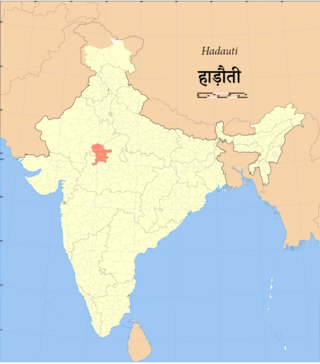
The Indo-Aryan languages are a branch of the Indo-Iranian languages in the Indo-European language family. As of the early 21st century, they have more than 800 million speakers, primarily concentrated in India, Pakistan, Sri Lanka, Bangladesh, Nepal and Maldives. Moreover, apart from the Indian subcontinent, large immigrant and expatriate Indo-Aryan–speaking communities live in Northwestern Europe, Western Asia, North America, the Caribbean, Southeast Africa, Polynesia and Australia, along with several million speakers of Romani languages primarily concentrated in Southeastern Europe. There are over 200 known Indo-Aryan languages.

Gujarati is an Indo-Aryan language native to the Indian state of Gujarat and spoken predominantly by the Gujarati people. Gujarati is descended from Old Gujarati. In India, it is one of the 22 scheduled languages of the Union. It is also the official language in the state of Gujarat, as well as an official language in the union territory of Dadra and Nagar Haveli and Daman and Diu. As of 2011, Gujarati is the 6th most widely spoken language in India by number of native speakers, spoken by 55.5 million speakers which amounts to about 4.5% of the total Indian population. It is the 26th most widely spoken language in the world by number of native speakers as of 2007.

Marwari is a language within the Rajasthani language family of the Indo-Aryan languages. Marwari and its closely related varieties like Dhundhari, Shekhawati and Mewari form a part of the broader Marwari language family. It is spoken in the Indian state of Rajasthan, as well as the neighbouring states of Gujarat and Haryana, some adjacent areas in eastern parts of Pakistan, and some migrant communities in Nepal. Most prominent languages included within Marwari are Marwari,. There are two dozen varieties of Marwari. Marwari is also referred to as simply Rajasthani.

Malwa is a historical region of west-central India occupying a plateau of volcanic origin. Geologically, the Malwa Plateau generally refers to the volcanic upland north of the Vindhya Range. Politically and administratively, it is also synonymous with the former state of Madhya Bharat which was later merged with Madhya Pradesh. At present the historical Malwa region includes districts of western Madhya Pradesh and parts of south-eastern Rajasthan. Sometimes the definition of Malwa is extended to include the Nimar region south of the Vindhyas.

The Northern Indo-Aryan languages, also known as Pahāṛi languages, are a proposed group of Indo-Aryan languages spoken in the lower ranges of the Himalayas, from Nepal in the east, through the Indian states of Jammu and Kashmir, Uttarakhand, Himachal Pradesh and Punjab was coined by G. A. Grierson.

Hadauti or Harauti (Hadoti) is an Indo-Aryan language of Rajasthani languages group spoken by approximately four million people in the Hadoti region of southeastern Rajasthan, India. Its speakers are concentrated in the districts of Kota, Baran, Bundi and Jhalawar in Rajasthan, as well as in neighbouring areas of Madhya Pradesh.

The Hindi Belt, also known as the Hindi Heartland, is a linguistic region encompassing parts of northern, central, eastern, and western India where various Northern, Central, Eastern and Western Indo-Aryan languages are spoken, which in a broader sense is termed as Hindi languages, with Standard Hindi serving as the lingua franca of the region.

Rajasthani languages are a branch of Western Indo-Aryan languages. It is spoken primarily in the state of Rajasthan and adjacent areas of Haryana, Gujarat and Madhya Pradesh in India. There are also speakers in the Pakistani provinces of Punjab and Sindh. Rajasthani is also spoken to a lesser extent in Nepal where it is spoken by 25,394 people according to the 2011 Census of Nepal.

The voiced retroflex lateral flap is a type of consonantal sound, used in some spoken languages. The 'implicit' symbol in the International Phonetic Alphabet is ⟨𝼈 ⟩. The sound may also be transcribed as a short ⟨ɭ̆ ⟩, or with the retired IPA dot diacritic, ⟨ɺ̣⟩.

Chhindwara district is one of the major districts of Madhya Pradesh state of India, and Chhindwara town is the district headquarters. Chhindwara was the largest district in Madhya Pradesh with an area of 10,293 square km before the bifurcation of Pandhurna district. The district is part of Jabalpur division.
Rajput is a large multi-component cluster of castes, kin bodies, and local groups, sharing social status and ideology of genealogical descent originating from the Indian subcontinent. The term Rajput covers various patrilineal clans historically associated with warriorhood. All these Rajput clans are descended from the Vedic Kshatriyas. There are four major branches of Vedic Kshatriyas which are Suryavansh, Chandravansh, Agnivansh and Rishivansh.

Colin Paul Masica was an American linguist who was professor emeritus in the Department of South Asian Languages and Civilizations and the Department of Linguistics at the University of Chicago. Besides being a specialist in Indo-Aryan languages, much of his work was on the typological convergence of languages belonging to different linguistic families in the South Asian area and beyond, more broadly on this phenomenon in general, and on possible explanations for it and implications of it in connection with both linguistic and cultural history.
Ahirwati is an Indo-Aryan dialect of India. It is spoken within the Ahirwal region located to the south-west of the capital Delhi. It belongs to the Rajasthani language group and is commonly taken to be a dialect of Mewati, but in many respects it is intermediate with the neighbouring varieties of Bangru and Bagri, and is especially close to Shekhawati.

Bhatri is an Eastern Indo-Aryan language spoken by the Bhottada tribe in Chhattisgarh and Odisha, India. The language is spoken predominantly in eastern Bastar district and in Koraput and Nabarangpur districts of Odisha.
Kanjari is an unclassified Indic tribal language of India associated with the Kanjar tribe. It is written using the Devanagari script. Kanjari is spoken in Andhra Pradesh, Madhya Pradesh, Uttar Pradesh and Rajasthan. It may be one of the Punjabi languages. UNESCO classifies Kanjari as an endangered language. Some may use the word to describe Karina.
Ahiri may refer to either of the following Indo-Aryan language varieties of India:
Powari is an Indo-Aryan language spoken primarily in Madhya Pradesh and Eastern Maharashtra. It belongs to the Hindi subgroup.
Rangri may refer to the following Indo-Aryan dialects:
Desia, also Desiya or Desia Odia or Koraputi Odia or Southwestern Odia, is an Indo-Aryan language variety spoken in Koraput, Nabarangpur, Rayagada, Malkangiri districts Odisha and in the hilly regions of Vishakhapatnam and Vizianagaram districts of Andhra Pradesh. The variant spoken in Koraput is called Koraputia.












